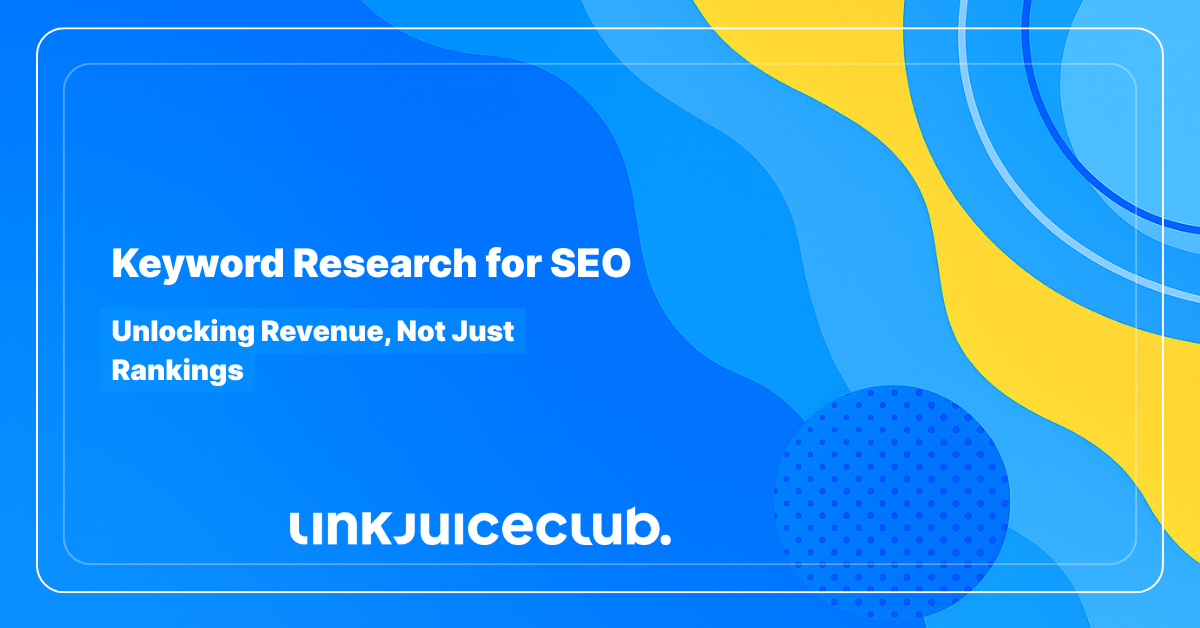
Keyword Research for SEO: Unlocking Revenue, Not Just Rankings
Keyword research for SEO isn’t just a numbers game. It’s about finding the queries that don’t just bring visitors, but customers. Growth isn’t built on clicks alone — it’s built on intent.
Most folks chase keywords like butterflies — pretty, fast-moving, and impossible to pin down. But real SEO pros? They hunt with a sharper aim.
We’re diving deep into a smarter way to scout, select, and scale with the right keywords — the kind that quietly stack up revenue while your competitors are busy flexing traffic stats.

Get ready to turn every search term into a sales trigger. 🔥
Most Keyword Research Misses the Mark — Here’s Why
Before putting pen to paper, we did what every SEO should: scanned the digital horizon. We sifted through the usual suspects — those endless guides promising keyword gold.
And yet, they all missed one thing.
They told you how to chase traffic, but never asked why you’re chasing it in the first place.
Think of it like mapping out a road trip without knowing the destination. You might move fast, but are you going anywhere that actually matters?
The “Why” Behind Keyword Research (That Everyone Ignores)
Let’s break this down.
Ask the average SEO why they’re doing keyword research and you’ll hear: “To get more traffic.”
That answer? It’s incomplete — and in most cases, flat-out wrong.
Because unless you’re running a media site that thrives on CPMs and ad clicks, traffic isn’t the finish line. It’s just noise if it doesn’t turn into something meaningful.
Here’s what keyword research should be chasing:
- 🎯 Revenue-generating intent
- 🛒 Buyers, not browsers
- 📈 Business growth — not vanity metrics
Some might talk about brand awareness or sprinkle in funnel jargon. Sure, it sounds strategic — but in the wild, those plans often fizzle before they pay off.
Why? Because they lack one vital ingredient: measurable, monetizable impact.
So What’s the Real Point of Keyword Research?
Let’s call it what it is:
You’re not searching for words. You’re hunting for revenue.
Every keyword you choose should be a thread that ties back to your business goals. Not just visits, but conversions, customers, cash flow.
That means looking beyond what people are searching for and asking: How does this search lead to a sale?
Before we dive into the process, we need to understand the mechanics of how money is made online because only then can you map keywords to profit, not just pageviews.
How Brands Actually Make Money from SEO: The One Rule That Changes Everything
Let’s cut to the chase: SEO drives profit through leads and sales, not likes, shares, or empty traffic spikes.
And here’s where the house of cards starts to wobble.
For years, SEO strategy has been treated like a buffet: optimize for every stage of the funnel and hope the conversion gods deliver.
But that playbook? It’s outdated. Let’s flip the script.
The Funnel Trap That Keeps Brands Stuck
The marketing world loves its funnel. It usually looks like this:
Awareness → Consideration → Decision
So what do most SEOs do? They start building content for every stage:
- 🧠 TOFU (Top-of-Funnel): “Let’s educate and inspire!”
- 🤔 MOFU (Middle-of-Funnel): “Let’s compare options.”
- 💰 BOFU (Bottom-of-Funnel): “Let’s close the deal.”
Sounds strategic, right? Here’s the catch.
This funnel-first mindset leads to websites bloated with blog posts, buying guides, and “ultimate checklists” for every keyword under the sun. The idea? More traffic means more chances to win.
But the truth is…
Most traffic is meaningless unless it meets people at the exact moment they’re ready to act.
Your Audience Has a Full Inbox — and an Even Fuller Brain
When crafting a keyword strategy, I always come back to one thing: people forget fast.
Not because they don’t care, but because their brains are already juggling a thousand things — appointments, passwords, coffee orders, birthdays they forgot again. 🧠
There’s a principle in psychology called the forgetting curve — it shows how quickly we lose information that isn’t reinforced or immediately useful. It’s like trying to hold water in your hands.
Memory Is Slippery — Even When the Content Is Great
If you ask someone to name five articles they read this week or a few creators they follow, chances are they’ll pause. Not because they didn’t read — but because those names didn’t stick.
I’ve even asked clients to name ten toothpaste brands. You’d think that would be easy. It’s not.
That’s how fragile recall is — even for things we use every day.
So imagine what happens when someone reads your blog post once, six months ago, while half-distracted on their phone. Expecting them to remember your brand? That’s a fantasy.
The Fairytale of the 3,000-Word Memory Trigger
There’s a beloved myth in SEO: if we create long, comprehensive content, people will remember us when it matters.
Sounds good. But here’s what that thinking actually suggests:
“I need dog food. Oh! I remember that guide on 400 Dachshund names I read eight months ago. Let me go find that site and buy from them.”
It doesn’t happen like that. People don’t recall brands through content alone — not without repetition, reinforcement, or relevance.
Traffic Isn’t the Same as Trust
Let’s clear something up: traffic doesn’t equal brand awareness — and it definitely doesn’t equal conversions.
Racking up visits from broad, top-of-funnel content might look good on a dashboard. But it rarely moves the needle.
Why? Because that kind of content catches people before they care — not when they’re ready to take action.
That’s why traditional funnels mislead. They treat SEO like it’s a campaign — when really, it’s infrastructure.
SEO Is the Bridge, Not the Billboard
Think of search not as a stage, but as a pathway — one your future customers walk when they’re trying to solve a problem, compare options, or make a decision.
Great SEO doesn’t shout from the rooftops. It quietly appears at just the right moment, like a well-placed signpost.
That’s the smarter play: meet intent, not just interest. Guide decisions, not just impressions.
💡 Shift your thinking:
- SEO isn’t for reminding — it’s for connecting
- Don’t aim for “top of mind” — aim for “right on time”
- Instead of building funnels, build pathways to action
Realigning the Strategy: From Traffic to Timing
Marketing strategist Tom Roach proposed a more honest view of how people actually engage with brands. In his model, SEO isn’t noise at the top — it’s the link between curiosity and commitment.
This is where search thrives: right at the edge of decision-making.
If we treat SEO like a tool for timely connection then keyword research becomes a precision instrument, not a shotgun.
And with that mindset in place, it’s time to zoom in on what matters most:
The keyword process that actually leads to revenue.
Building a Keyword Strategy That Actually Moves the Needle
Every SEO plan starts with one hard truth: your brand is forgettable — unless you show up when it matters most.

And that means your keyword strategy needs more than a list of terms. It needs purpose, timing, and a dose of realism.
The buyer’s journey today doesn’t begin in your funnel — it begins in a search bar. And those first queries? They’re simple, broad, and often expensive in paid channels. These are your “head terms” — high search volume, high competition, and not always the best place to start.
So before you even choose a keyword, ask yourself:
- What does the client really want to achieve?
- What can their budget realistically support?
- Are we chasing impressions or actual outcomes?
📌 Use a SMART filter to stay grounded:
- Specific: Which product or service is the priority?
- Measurable: Where do rankings stand right now?
- Achievable: Is this doable with current resources?
- Relevant: Does this align with business growth?
- Timed: When can we expect to see traction?
This is about building a keyword system that fits the reality of your resources and revenue goals.
Researching What Customers and Competitors Are Really Searching
To understand what your audience needs, you need to gather search behavior — not guess it.
🔍 Here’s where you can mine for real-world data:
- CRM and internal business data
- Google Search Console
- Paid search insights (Google Ads, etc.)
- GA4 behavior flows
- Keyword tools (SEMRush, Ahrefs, etc.)
- ChatGPT or other AI models for ideation
Yes — even ChatGPT can be surprisingly useful here. Prompt it with a scenario, and it can spit out keyword themes based on real logic and consumer behavior.
🎯 Example: For a fish tank brand, you’ll see patterns like:
- Size-based queries (“small fish tanks for apartments”)
- Type-based searches (“saltwater tanks vs freshwater”)
- Brand-specific questions
- Material-specific needs
Don’t overthink the toolset, just gather insight from everywhere. The goal is to build a realistic picture of how your future customer shops, thinks, and searches.
Mapping the Keyword Journey (So You Can Meet Buyers Where They Are)
This is where strategy kicks in.
Once you understand your audience’s intent, it’s time to map the journey — from first click to final decision.
Imagine you’re searching for car insurance for your teenager. Your early search might be “cheap car insurance for new drivers.” You scroll, skim, bounce — life interrupts.
Two weeks later, the need resurfaces. This time, you go deeper:
“How to reduce car insurance for teens?” →
“Best policies for 17-year-old drivers” →
“Does mileage affect teen driver premiums?”
Welcome to the messy middle — where most search decisions are made.
This is the moment where brands win or vanish. If you’re not in the mix, you’re not in the consideration set.
💥 Here’s how to organize the keyword stages:
| Keyword Type | Purpose | Search Behavior |
| Head Terms | General interest or awareness | “home gym” |
| Body Keywords | Deeper keyword research and comparison | “best home gym setups for small spaces” |
| Long-Tail Terms | Purchase-ready and specific | “adjustable dumbbells under $300 for beginners” |
Not every client will have the budget to chase head terms. That’s fine — the gold often lies in the long tail, where intent is higher and competition lower.
Selecting Keywords That Pull Their Weight
Now that you’ve gathered a mountain of keyword insights, it’s time to get selective. Not all search terms deserve a seat at your strategy table.
We’re building two clear keyword groups — each playing a distinct role in your funnel:
1. Discovery Keywords
These are the signals that someone is just entering the arena. They’re curious. They’re open. They want ideas.
2. Decision Keywords
These are the moments when someone is comparing, judging, and moving toward a final choice.
🎯 The messy middle of search lives between these two. That’s where your brand needs to show up with the right offer, at the right time.
Mapping Keyword Needs to Human Emotions
Most search journeys are emotional — not just informational. Behind every query is a feeling: frustration, excitement, confusion, or doubt.
So let’s organize keywords based on what the user needs in that moment — not just what they type.
Discovery Keywords: Spark Interest, Inspire Action
These help users explore options, get inspired, or define their problem.
| Need Type | Examples |
| “Show me what’s out there” | “home office ideas for small rooms” |
| “Make it fun or cool” | “unique standing desk setups” |
| “Teach me the basics” | “what’s the difference between ergonomic chairs” |
| “Help me choose” | “how to pick the right lighting for Zoom calls” |
Decision Keywords: Build Trust, Push Conversion
These appear when users are ready to weigh options and get serious about purchase.
| Need Type | Examples |
| “Prove you’re the one” | “top-rated ergonomic desk chairs for long hours” |
| “Remind me why it’s worth it” | “standing desk benefits for posture” |
| “Give me peace of mind” | “is XYZ furniture brand legit reviews” |
Match Each Keyword With a Real Asset
Don’t just collect keywords — give them a home.
| Intent | Asset Ideas |
| Inform & guide | Step-by-step tutorials, how-to hubs |
| Compare & evaluate | Versus pages, pros/cons breakdowns |
| Reassure | Testimonials, case studies, trust badges |
| Convert | Focused landing pages, calculators, offers |
| Delight | Free templates, interactive tools, quick tips |
Time to Vet Your Keywords (Manually)
Now comes the part that most guides oddly start with — but smart SEOs save for last.
You’ve got your keyword list. You’ve got mapped assets. Now ask: Is it commercially viable?
✅ Run your filters:
- Is the intent high enough to justify effort?
- Can the client realistically rank for this?
- Is there a clear asset match?
- What does the SERP actually look like?
Don’t get caught up in tool dependency. SEMrush, Ahrefs, Moz, or Google’s own tools — they’re just lenses. The process is what matters.
Testing the Real-World Value of Your Keywords
By now, you’ve built a foundation — keyword research has borne results, you’ve mapped to actual search needs, paired with smart content ideas.
But here’s the final test: Can your business actually win with these keywords?
This is where manual review steps in. You’re no longer just looking at what people search — you’re weighing whether it’s worth going after.
🛠️ Time to assess:
- Search volume: Is there enough interest to justify content creation?
- Competition: Are the SERPs dominated by giants or ripe for disruption?
- Resources: Can your team realistically produce and support this asset?
- Timeline: How long will it take to rank — and can you afford to wait?
- Potential ROI: What’s the upside if this page wins?
Let’s say your data showed a high interest in pricing-related queries. You decide to build an interactive cost calculator — great idea. But before launch, you’ll run those keywords through your filters. If the reward outweighs the effort, it’s a go.
This is how you move from keyword theory to keyword revenue.
The Bottom Line: A Keyword Process That Prioritizes Profit
Most keyword research advice starts with tools and tactics.
But the real pros? They start with people — and end with performance.
Here’s a high-level recap of the entire process:
🧭 1. Build your strategy
Set SMART objectives. Know what you’re aiming for — and what the client can realistically afford.
🔍 2. Explore customer & competitor behavior
Use every data source available to understand search behavior. Blend analytics with human insight.
🗺️ 3. Map the buyer’s journey
Categorize keywords into head, body, and long-tail — and align them with real moments of decision-making.
🧠 4. Generate keyword ideas
Create a shortlist based on emotional triggers and practical needs. Think beyond volume — think usefulness.
📦 5. Match keywords to assets
Design content formats that serve the user, not just rank in SERPs. Tools, guides, reviews, landing pages — whatever fits.
📈 6. Validate for commercial viability
Check search volume, timeline, cost, and effort. Only keep the keywords that have a clear business upside.
When your keyword research is shaped around intent, not just traffic, you stop chasing numbers — and start building value.
This isn’t just SEO. It’s strategic content that earns attention, trust, and revenue — one smart search at a time.





